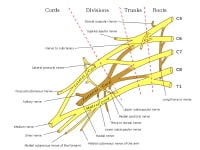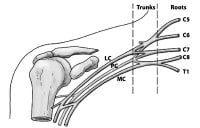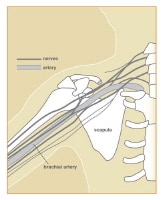The brachial plexus
(plexus brachialis) is a somatic nerve plexus formed by
intercommunications among the ventral rami (roots) of the lower 4
cervical nerves (C5-C8) and the first thoracic nerve (T1). The plexus,
depicted in the images below, is responsible for the motor innervation
of all of the muscles of the upper extremity, with the exception of the
trapezius and levator scapula.[1]
 Schema of the brachial plexus.
Schema of the brachial plexus.  The
basic anatomical relationships of the brachial plexus (BP). The BP is
subdivided into roots, trunks, divisions, cords, and branches. LC stands
for lateral cord, PC stands for the posterior cord, and MC stands for
the medial cord.
The
basic anatomical relationships of the brachial plexus (BP). The BP is
subdivided into roots, trunks, divisions, cords, and branches. LC stands
for lateral cord, PC stands for the posterior cord, and MC stands for
the medial cord.  Diagram showing relationships of the brachial plexus (BP) to the sternum, scapula, and humerus. The brachial plexus
supplies all of the cutaneous innervation of the upper limb, except for
the area of the axilla (which is supplied by the supraclavicular nerve)
and the dorsal scapula area, which is supplied by cutaneous branches of
the dorsal rami.
Diagram showing relationships of the brachial plexus (BP) to the sternum, scapula, and humerus. The brachial plexus
supplies all of the cutaneous innervation of the upper limb, except for
the area of the axilla (which is supplied by the supraclavicular nerve)
and the dorsal scapula area, which is supplied by cutaneous branches of
the dorsal rami.
The brachial plexus communicates with the sympathetic trunk via gray rami communicantes, which join the roots of the plexus. They are derived from the middle and inferior cervical sympathetic ganglia and the first thoracic sympathetic ganglion.
 Schema of the brachial plexus.
Schema of the brachial plexus.  The
basic anatomical relationships of the brachial plexus (BP). The BP is
subdivided into roots, trunks, divisions, cords, and branches. LC stands
for lateral cord, PC stands for the posterior cord, and MC stands for
the medial cord.
The
basic anatomical relationships of the brachial plexus (BP). The BP is
subdivided into roots, trunks, divisions, cords, and branches. LC stands
for lateral cord, PC stands for the posterior cord, and MC stands for
the medial cord.  Diagram showing relationships of the brachial plexus (BP) to the sternum, scapula, and humerus. The brachial plexus
supplies all of the cutaneous innervation of the upper limb, except for
the area of the axilla (which is supplied by the supraclavicular nerve)
and the dorsal scapula area, which is supplied by cutaneous branches of
the dorsal rami.
Diagram showing relationships of the brachial plexus (BP) to the sternum, scapula, and humerus. The brachial plexus
supplies all of the cutaneous innervation of the upper limb, except for
the area of the axilla (which is supplied by the supraclavicular nerve)
and the dorsal scapula area, which is supplied by cutaneous branches of
the dorsal rami.The brachial plexus communicates with the sympathetic trunk via gray rami communicantes, which join the roots of the plexus. They are derived from the middle and inferior cervical sympathetic ganglia and the first thoracic sympathetic ganglion.

0 التعليقات:
إرسال تعليق